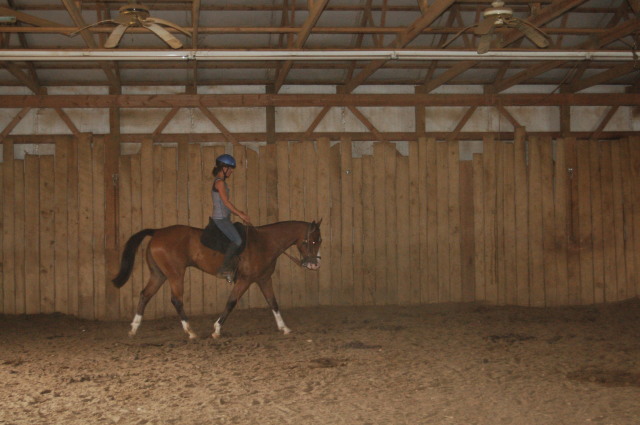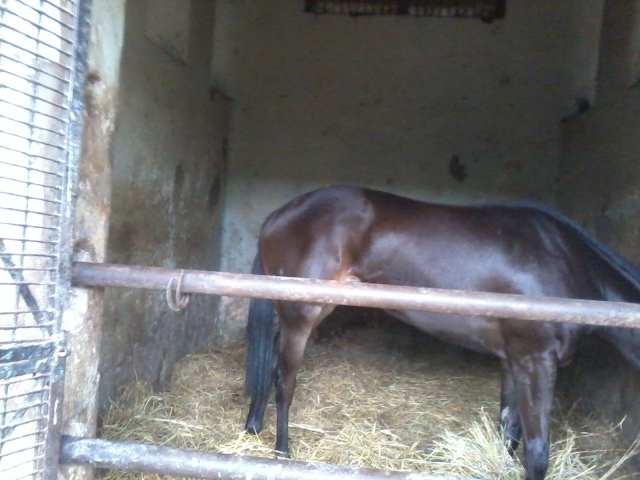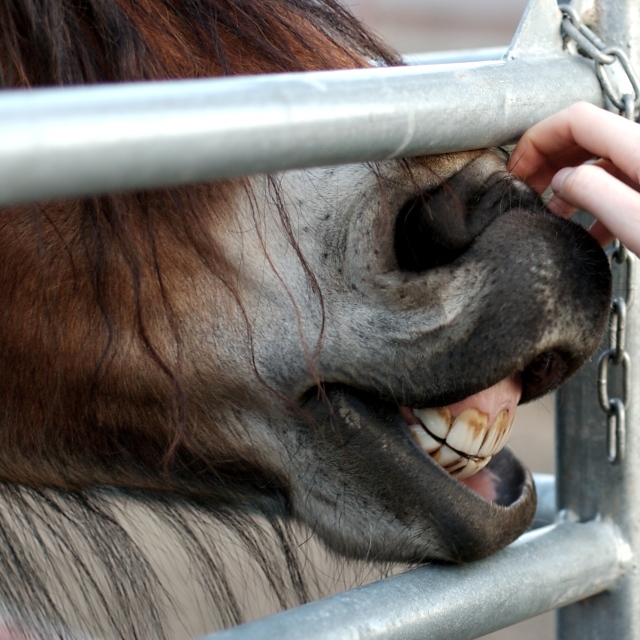QuestionOK, not quite. I have an 19yr. old Morgan mare who has decided(maybe not)not to let me brush her behind her girth.Flatten ears,kicking............I can clean her feet, face and neck, mane,tail, then the fun begins. Part of me wants to whollop her one,but gee, what if there is another problem? She has been tested for Cushings(neg.), may possibly have insulin resistance;We have changed her diet accordingly, Added some supplements(vit.E,C,flaxseed meal).Maybe I need to do more.This is more than "she's in heat", This behavior is everyday for the last 3 months.Riding has been a luxury,though she still has her get up and go when we do go.Have not tried to cinch her up lately(I could die!!)But I suppose that might be useful info.She moves around the pasture fine,for 19 years old.Any ideas or other avenues I may want to explore?My Vet is a nice guy,but sort of stuck in his ways.Thanks for any thoughts. Kindly, lori Dean
AnswerHi Lori, I'm really glad you asked me this question, as this issue is very prevalent out there. My experience is that this issue is so common that it's considered by most people, horse trainers, and vets to be just bad behavior. Because she started exhibiting this response to brushing in the last 3 months, it seems she is trying to communicate that something is different than it once was. For ease of answering the question, I'll call this being "girthy" because I'm pretty sure she'll exhibit this behavior to some degree whether she's being brushed behind the area or actually getting girthed.
Many horses get a look of concern with even light palpation of the tissues underlying the girth area; very commonly horses appear to suffer moderate pain around this area, and just learn to accept it. It is likely that there are one or more joint fixations irritating the nerves that pass between the affected vertebrae, and over the joints between the vertebrae and ribs, producing the pain reactions. Horses usually react as though the nerve path between the affected ribs is very tender. This tenderness may be palpable from the border of the shoulder blade all the way down to the pectoral muscles, near where the girth is placed at the bottom of the chest and slightly behind.
In many horses girth irritability or pain is there but is low grade. Most, I believe, learn to live with it. The horse, with considerable discomfort or pain, has to either put up with the problem, or do things to evade the pain, such as biting at the handler, inflating the chest to splint the ribs, kicking, frowning, pinning ears, grunting, lifting the head and swishing the tail. I would suspect that if you did girth her up and ride her right now she would "short step," be "one-sided," resist leg aids, maybe even "hump up" at the start of a ride, especially during the transition from trot to canter on the most affected side, then settle in after 10-20 minutes as though nothing had ever been wrong.
This is a condition that responds very favorably to chiropractic care. An equine chiropractor would check very closely the 3rd through the 8th thoracic vertebrae and the costovertebral joints associated with those vertebrae. Adjusting the affected areas usually brings an immediate improvement, and at times the results are nothing short of spectacular. Additionally, massage of the girth and wither area is helpful and will, where tolerated, at least give temporary relief. "Shoulder in" exercise in one of the most useful exercises that can be employed to get horses to better flex their rib cage and can help to maintain ribcage flexibility once the spinal mobility fixations and pain have been resolved.
One great self-help management option is to encourage your mare to stretch her topline with exercises that ask her to pick up the front of her chest. These exercises ease the tensions that contribute to pain and fixation. The neck exercise that involves having your mare nibble a carrot between her front legs also helps to ease this tension. Stretching out each foreleg is also useful. You will want to warm your mare up by walking her for 5-10 minutes before attempting any of these stretches.
"Girthiness" exhibited by brushing in the area is a major problem in horses. They are suffering pain, their performance is reduced, and their behavior is often adversely affected and, at times, dangerous. For the sake of both you and your mare, this problem needs treatment that is aimed at the cause, rather than just being managed.
Please let me know how this comes out. Obviously you take very good care of her; I love the vitamins and flaxseed meal for the omega fatty acids.

 Bucking and running while longeing
QuestionRiding
QUESTION: I have a 7 yr unregiste
Bucking and running while longeing
QuestionRiding
QUESTION: I have a 7 yr unregiste
 Sores on horses
QuestionQUESTION: this is kinda gross so i apologize to
Sores on horses
QuestionQUESTION: this is kinda gross so i apologize to
 saddle
Question
saddle
I recently acquired a saddle made by He
saddle
Question
saddle
I recently acquired a saddle made by He
 very good hind end confirmation
Question
hind end
hello maam. i believe that thi
very good hind end confirmation
Question
hind end
hello maam. i believe that thi
 horse age
Question
horse age
hello, can you guess the horse age?
horse age
Question
horse age
hello, can you guess the horse age?